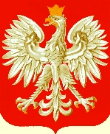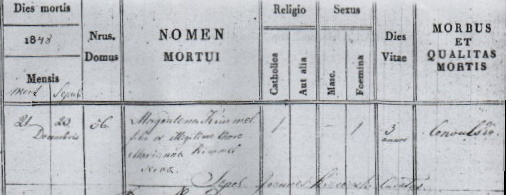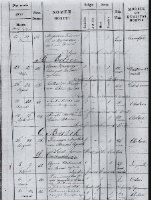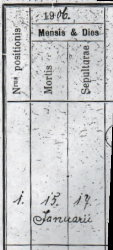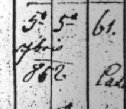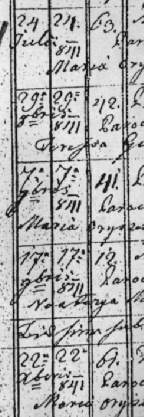Death Record, Part 1Click on any part of the record above for a description and to go to that explanation. Or you can scroll down the page on your own.
The parish priest kept a record of all deaths occurring in the parish. Before 1784 the records for all the villages in the parish were kept together. However, after 1784, records for each particular village were kept separately. They may have been bound in the same book, but a separate listing for each village was organized alphabetically by village, year by year. When searching for ancestors, never concentrate solely on one village, or even one parish for that matter. Although itís commonly thought that people never moved great distances outside their birth village, you will find people often marrying into families in neighboring villages and/or parishes.
Explanation of each column 1. Numerus Serialis or Nr. posit./ Nrus positionis (Serial Number or Position Number)
The priest numbered each record of death and burial sequentially (1, 2, 3, etc.). Each year the priest started over with number one. This was done to show that no oneís name could have been added or removed at a later date. In this example, this was the first death in the village that year. This simple information can be used by the genealogist to help cite information for your own family history. This extra citation will ensure your proper record keeping. Of course, it is not essential. However, if you would like this extra "protection", especially if the death record contains names in a foreign language, in particular a foreign alphabet, you may do this. Furthermore, by tracking the sequential numbering of the births, one can determine any missing pages or pages out of order (which sometimes happens when researching microfilmed copies that may have been microfilmed out of order). On some forms, this information is not found as is the case in the example at the top of the page.
2.
Dies et Mensis Mortis et Sepulturae (Day and Month of Death and Burial)
|
| Anna de Majewska | de "of" |
| Anna de domo Majewska or Majewskich | de domo "of the house of" |
| Anna ex Majewski | ex "from" |
| Anna nata Majewska | nata "born (with the maiden name)" |
 In
this example, it reads Angella Olejnik, born Brzezicka <maiden name>, wife of
the left-behind Ignacy (Ihnat in Ukr.) the farmer.
In
this example, it reads Angella Olejnik, born Brzezicka <maiden name>, wife of
the left-behind Ignacy (Ihnat in Ukr.) the farmer.
If you donít see this information for a woman, you can not assume that the surname listed is her maiden name. More than likely it is the surname of her husband. Youíll have to search for a marriage record to determine the wifeís maiden name.
With a childís name is often included the name of the parents. This example reads: "Maria Makarowska, legitimate daughter of Stefan and Anna Gieża, farmers."
Look for the Latin terms:
filius "son of..."
filia "daughter of..."
sometimes abbreviated for both "fil."
filius leg. legitimate son
filia leg. legitimate daughter
fil. leg. abbreviation for both
These Latin terms would then require the genitive case of the following name, so you must be careful about noting the correct name. See my section on language and names for more detail.
Regarding geographic locations, the priest may have included information on the deceasedís birthplace and/or residence at time of death. Some other Latin terms to watch out for are:
habit. in + place name residing in...
(habitat =he/she resides. habitans = resident)
de + place name from...
nat. in + place name born in...
natus = (he was) born; nata = (she was) born
oriundus (man) / oriunda (woman) originating
from
Other Latin terms that may be found in this column:
post delictus (for a man) / post delicta (for a woman) or abbreviated p.d.:
deceased
derelicto marito: left-behind husband
(maritus = husband)
vidua post mortum: widow of the previously deceased <husbandís name>
defuntus, defuncti: deceased, of the deceased (for men)
defunta, defunctae: deceased, of the deceased (for women)
coelebs: unmarried
| Latin | Ukrainian first names | Polish first names |
| Helena, derelicto mariti Tadeusza | Olena, wife of the left-behind Fadei | Helena, wife of the left-behind Tadeusz |
| Marcin derelicta uxore Jozefy | Martyn, husband of the left-behind Iosypa | Marcin, husband of the left-behind Jozefa |
| Katarzyna derelicto marito Jana | Kateryna, wife of the left-behind Ivan | Katarzyna, wife of the left-behind Jan |
Pay particular attention to the names of the spouses. Remarriage was very popular in the event of a spouseís death. Reasons based on financial, social and religious well being vary for the individual. The surname listed for the woman may be her maiden name, the surname of her first husband, or the surname of her current husband. In turn, you must be careful of these names in the future. A woman may be referred to in future records of her childrenís and grandchildrenís births, marriages, and death records with her own maiden name, the first husbandís surname or current surname. A thorough study of all of the womanís ancestors, even of the entire village, is necessary in order to track this properly. Of course, as always, you must be aware of the possibility of priest error, or copy error when looking at the Bishopís Copies.
You may also find information pertaining to the deceasedís occupation.
|
www.halgal.com
Questions and Comments to Matthew
Bielawa |
